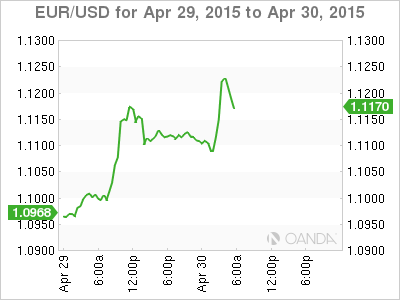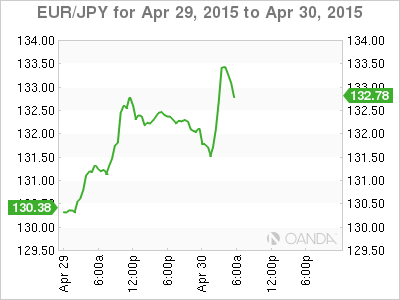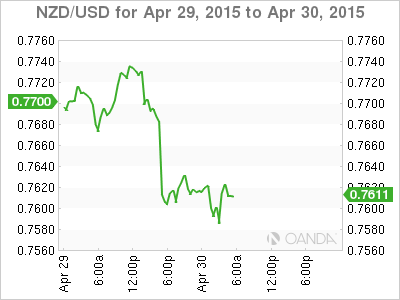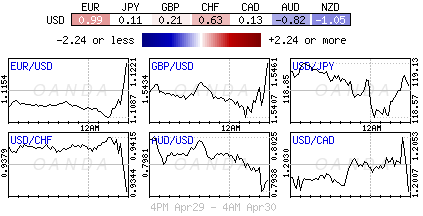German Bund Yields disrupt all asset classes
Yield backup driven by “hot” money accounts
EUR expected to remain better bid through month-end
Kiwi Tries to Fly but Crashes
Sovereign bonds have been selling off hard over the past two-days as a number of factors send yields higher. For the first time in nearly a month, the US 10-year yield is trading outside the +1.8-2.0% range (+2.05%) while the German 10-year Bund has backed up +18bps to +0.29%.
The start of the broad dollar weakness can be attributed to the dovish shift in Fed expectations, but the EUR rally over the past two-session in particular is being supported by the assertive rally in German Bund yields. The ECB’s aggressive QE program has encouraged investors to own core Eurozone bonds and stocks, alongside a massive build up in EUR short positions (+78% of USD longs have been against the EUR).
The yield rally can be attributed to a number of factors. First, more and more money managers have been talking about the rich potential of the “short” position on European bonds.
Over the past ten-day’s, 10-year German debt has backed up +23bps as investor’s appetite for fixed income with a negative or flat return diminishes. The loss in fixed income has pressured the DAX and in turn has encouraged some aggressive EUR/USD short covering. The rise in German yields is also encouraging investors to consider switching from EUR to JPY as the funding currency of choice.
Second, yesterday’s euro zone March money supply report was stronger than estimated, with M3 growth rising more than expected to +4.6%, putting it back into the ECB’s comfort zone for the first time in six-years. Finally, there is and has been a plethora of euro-denominated corporate issuance this week. When supply is greater than demand, dealers will make room to take it down.
EUR: Where to from here?
The powerful back up in German yields has naturally forced the liquidation of more “hot” money long positions and not necessarily “real” money accounts that have been established before the introductions of the ECB’s QE program. In reality, the violent price action has not given real account holders the time, or the opportunity over the past two-sessions. It would require more than a couple of days of poor price action to convince the real account holders to bail on these positions – from their perspective, the ECB is still providing monthly support. Once month end requirements are out of the way, investors should expect some price consolidation, which will allow Bunds to stabilize in the near term.
The EUR’s moves after the disappointing U.S. GDP print (+0.2% vs. +1%) and the Fed statement yesterday has certainly surprised many of the dollar bulls and has resulted in greater uncertainty. The EUR’s extension this morning, breaking through the psychological €1.1200 handle with momentum, certainly forced some investors to reduce their risk exposure and reassess expectations – short EUR position continue to be the largest forex position (+78% of all dollar longs). It would not come as a surprise to see the 19-member single unit continue to experience a period of outperformance, as month-end extension needs to be dealt with. For the time being, the EUR will be expected to be well bid on dips (low of the week €1.0816/60 April 27), at least until various asset classes stabilize.
Kiwi Tries to Fly but Crashes
The NZD ($0.7600) trades under pressure this morning after dairy giant Fonterra (responsible for 30% of the world’s dairy exports) cut its forecast payout to its +10.6k co-op farmers and the RBNZ moved to an easing bias.
The Kiwi has fallen from lofty heights (NZD$0.7752) despite the RBNZ Assistant Governor preparing the market for such a shift in monetary bias last week. For some time now, investors had been less bullish than the central bank as inflation missed expectations. But, traders obviously needed the message in black and white to justify the overnight currency move.
The RBNZ said that it would focus on the medium trend in inflation while noting downside risks to GDP, including from the high valued NZD. This would suggest that the chance of a rate cut would rise if core-inflation does not gradually pick up. The market is now beginning to price in a rate cut from +3.5% to +3% by year-end.
Next week the RBA meet and their below average GDP growth and inflation expectations have encouraged a split decision of an RBA rate cut. The Aussie trading near AUD$0.80c should look expensive to a Governor that has been very vocal about it being overvalued.
This article is for general information purposes only. It is not investment advice or a solution to buy or sell securities.
Opinions are the authors — not necessarily OANDA’s, its officers or directors. OANDA’s Terms of Use and Privacy Policy apply. Leveraged trading is high risk and not suitable for all. You could lose all of your deposited funds.
Recommended Content
Editors’ Picks
AUD/USD gains momentum above 0.6500 ahead of Australian Retail Sales data

AUD/USD trades in positive territory for six consecutive days around 0.6535 during the early Asian session on Monday. The upward momentum of the pair is bolstered by the hawkish stance from the Reserve Bank of Australia after the recent release of Consumer Price Index inflation data last week.
EUR/USD holds positive ground above 1.0700, eyes on German CPI data

EUR/USD trades on a stronger note around 1.0710 during the early Asian trading hours on Monday. The weaker US Dollar below the 106.00 mark provides some support to the major pair.
Gold trades on a softer note below $2,350 on hotter-than-expected US inflation data

Gold price trades on a softer note near $2,335 on Monday during the early Asian session. The recent US economic data showed that US inflationary pressures staying firm, which has added further to market doubts about near-term US Federal Reserve rate cuts.
Ethereum fees drops to lowest level since October, ETH sustains above $3,200

Ethereum’s high transaction fees has been a sticky issue for the blockchain in the past. This led to Layer 2 chains and scaling solutions developing alternatives for users looking to transact at a lower cost.
Week ahead: Hawkish risk as Fed and NFP on tap, Eurozone data eyed too

Fed meets on Wednesday as US inflation stays elevated. Will Friday’s jobs report bring relief or more angst for the markets? Eurozone flash GDP and CPI numbers in focus for the Euro.



